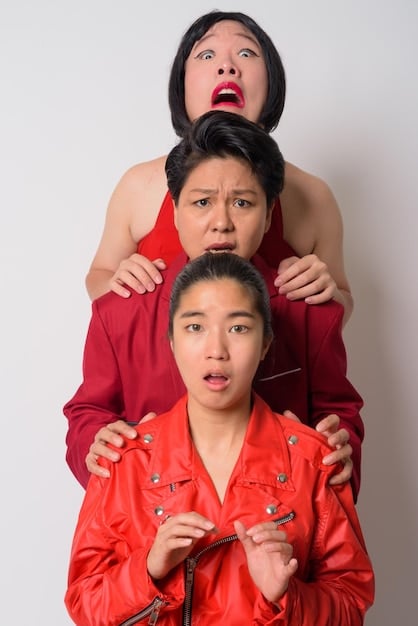Second Lead Syndrome: Why We Love Korean Drama Supporting Characters

Advertisements
The Power of Second Leads: Why Supporting Characters Often Steal the Show in Korean Dramas often lies in their compelling backstories, unwavering loyalty, and the unrequited love they offer, resonating deeply with viewers.
Korean dramas, or K-dramas, are known for their captivating storylines, beautiful cinematography, and, of course, their memorable characters. While the main leads often get the most attention, it’s the **power of second leads** that truly adds depth and complexity to these narratives, often stealing the show with their relatable struggles and endearing personalities.
Anúncios
The Allure of Second Leads in K-Dramas
Second leads in K-dramas possess magnetic appeal, becoming integral components of the narrative tapestry, and leaving an indelible mark on audiences. Their compelling narratives often rival, and sometimes even overshadow, those of the main leads.
But what is it about these supporting characters that captures our hearts and makes us root for them, even when we know they might not get the girl (or guy)?
Anúncios
Relatability and Authenticity
Second leads are often portrayed as more relatable and authentic than the main characters. They may have flaws, insecurities, and a vulnerability that resonates with viewers.
Untapped Potential
The appeal of second leads also stems from their untapped potential. They often start as underdogs, facing challenges and obstacles that test their character and resilience.

The power of these characters can be further explored through their:
- **Complex Backstories:** Second leads often have intricate backstories that add depth and complexity to their characters. These backstories can explore past traumas, family issues, or personal struggles that shape their motivations and actions.
- **Unwavering Loyalty:** One of the most endearing traits of second leads is their unwavering loyalty to the main characters. They are often the best friends, confidantes, or allies who stand by the protagonist through thick and thin.
- Realistic Portrayals:** Second leads are often depicted as ordinary people who grapple with everyday challenges like unrequited love, career setbacks, and identity crises. This realism makes them relatable.
In conclusion, the allure of second leads in K-dramas comes from their relatability, authenticity, and the untapped potential they possess. Their complex backstories, unwavering loyalty, and willingness to make sacrifices make them compelling characters that capture our hearts and leave a lasting impression.
The “Second Lead Syndrome” Phenomenon
The term “Second Lead Syndrome is frequently used amongst K-Drama audiences, and is quite a unique phenomenon. It refers to the intense emotional attachment that viewers develop for the supporting character who doesn’t end up with the protagonist.
Often, viewers find themselves more invested in the second lead’s journey than in the main couple’s romance.
Why Does Second Lead Syndrome Happen?
Second Lead Syndrome arises from several factors:
- Sympathy and Empathy: Viewers often sympathize with the second lead’s unrequited love and the pain of watching the protagonist choose someone else. This elicits empathy and a desire to see the second lead find happiness.
- Heartbreak: The heartbreak experienced by the second lead is often portrayed with such raw emotion that it resonates deeply with the viewers. This emotional connection can lead to a strong attachment to the character.
- Wish Fulfillment: Some viewers may identify with the second lead’s longing for love and their desire to be chosen. This can lead to a sense of vicarious wish fulfillment as they project their own desires onto the character.
Examples of Second Lead Syndrome
Some famous examples of Second Lead Syndrome include:
- “Boys Over Flowers” (2009): Ji-hoo (Kim Hyun-joong) constantly lost out to Jun-pyo (Lee Min-ho). His gentle nature and genuine affection for the female lead.
- “You’re Beautiful” (2009): Shin-woo (Jung Yong-hwa) provided unwavering support for Mi-nyeo (Park Shin-hye). He was so gentle and caring that many viewers wanted her to end up with him instead of Tae-kyung (Jang Keun-suk).
- “Reply 1988” (2015): Jung-hwan (Ryu Jun-yeol) was a fan favorite for his shy demeanour and subtle ways of showing love.
To conclude, “Second Lead Syndrome” is an interesting phenomenon where viewers develop a strong emotional attachment to supporting characters, and desire for the success of their narratives. This can be fuelled by empathy for unrequited love, heartbreak, and wish fulfilment.
Common Tropes and Archetypes
The second lead role adheres to some recurring tropes and archetypes, many of which contribute to their popularity.
Understanding these conventions can help us appreciate the nuances of their portrayals.

The Best Friend/Confidante
One common archetype is the loyal best friend or confidante who secretly harbors feelings for the protagonist. This character provides unwavering support and a shoulder to cry on, always putting the protagonist’s needs before their own.
The Cold Outsider
Another trope is the cold outsider who appears aloof and detached but secretly cares deeply for the protagonist. This character often has a hidden vulnerability or a tragic backstory that explains their reserved demeanor.
The Jerk with a Heart of Gold
The “jerk with a heart of gold” trope involves a character who initially comes across as arrogant, insensitive, or even rude but gradually reveals a softer, more compassionate side.
Recurring themes provide a foundation for writers to construct compelling narratives, and include:
- Unrequited Love: Second leads often experience unrequited love, which is a powerful and relatable theme. Their longing for the main character and the sacrifices they make for them tug at the heartstrings of viewers.
- Sacrifice and Selflessness: Second leads are often willing to sacrifice their own happiness for the sake of the protagonist. This selfless act of love and devotion is deeply admired by viewers.
- Growth and Transformation: Second leads often undergo significant growth and transformation throughout the drama. They may overcome personal obstacles, learn valuable life lessons, or find their own path to happiness.
In summary, common tropes and recurring themes contribute to the appeal of second leads. By understanding these conventions, we can better appreciate how these characters capture our attention.
Impact on the Narrative and Audience
The presence of a compelling second lead creates both internal conflicts in the narrative, and reactions from the audience who view them.
Their impact shapes the viewers experience of the drama by changing plot progression and viewer expectation.
Plot Twists and Tension
A well-developed second lead can introduce unexpected plot twists and create tension in the story. Their actions and decisions can challenge the protagonist’s choices and lead to dramatic conflicts.
Emotional Investment
Compelling second leads deepen the emotional investment of viewers in the drama. Viewers may find themselves torn between supporting the main couple and rooting for the second lead to find happiness.
Complex Relationships
Second leads can create complex relationships with both the protagonist and other characters in the drama. Their interactions can reveal hidden dynamics, expose vulnerabilities, and add layers of depth to the story.
The impact of a compelling second lead can be understood by examining:
- Ratings and Popularity: Second leads can significantly impact a drama’s ratings and popularity. A well-loved second lead can attract more viewers and generate positive buzz.
- Online Discussions and Fandom: Second leads often spark lively discussions and debates among viewers online. Fans create fan art, fan fiction, and videos dedicated to their favorite second leads.
- Actor Recognition: Playing a memorable second lead can boost an actor’s career and lead to more opportunities. Many actors have gained recognition and fame for their portrayal of iconic second leads.
Therefore, compelling second leads impact aspects of both the on-screen narrative, as well as audience engagement, turning them into drivers of excitement and discussion.
Memorable Second Leads in K-Drama History
Throughout K-drama history, certain second leads have stood out as particularly memorable and beloved.
These characters have left a lasting impression on viewers and have become iconic figures in the K-drama landscape.
“Sungkyunkwan Scandal” (2010): Gu Yong-ha (Song Joong-ki)
Known as the “playboy” of Sungkyunkwan, Gu Yong-ha was a charming and witty character who brought levity and humor to the drama.
“The Heirs” (2013): Choi Young-do (Kim Woo-bin)
Initially portrayed as a bully, Choi Young-do undergoes a transformation as he falls for the female lead. His rough exterior hides a vulnerable and lonely heart.
“Cheese in the Trap” (2016): Baek In-ho (Seo Kang-joon)
Baek In-ho is a talented pianist with a troubled past. His charming personality and genuine affection for the female lead made him a fan favorite.
The legacy and lasting impact of a character can be understood by exploring:
- Cultural Impact: Memorable second leads can become cultural icons, influencing fashion trends, slang, and even social attitudes. Their impact extends beyond the realm of entertainment.
- Lasting Appeal: Some second leads continue to be celebrated and remembered years after the drama has ended. Their stories resonate with viewers across generations.
- Influence on Future Dramas: Iconic second leads can influence the creation of future dramas, inspiring writers to create similarly complex and compelling supporting characters.
To conclude, there are many examples of great second leads throughout K-Drama history, each with important qualities. Some become cultural icons influencing fashion trends in a way that extends beyond simple entertainment.
How Second Lead Syndrome Affects Viewing and Enjoyment
Second Lead Syndrome can profoundly affect how viewers experience and enjoy K-dramas.
While it can enhance the viewing experience by adding emotional depth and complexity, it can also lead to frustration and disappointment.
Increased Engagement
Second Lead Syndrome can make viewers more engaged and invested in the drama. They become emotionally involved in the characters’ journeys and eagerly anticipate their fate.
Emotional Rollercoaster
Experiencing Second Lead Syndrome can be an emotional rollercoaster. Viewers may experience a range of emotions, from hope and anticipation to sadness and disappointment.
Altered Interpretations
Second Lead Syndrome can alter viewers’ interpretations of the drama. They may focus more on the second lead’s story than on the main couple’s romance, leading to a different understanding of the overall narrative.
The ultimate conclusion the viewer can draw from all of the above points may include:
- Acceptance: Some viewers come to accept the outcome of the drama and appreciate the second lead’s journey, even if they don’t end up with the protagonist.
- Disappointment and Frustration: Other viewers remain disappointed and frustrated by the second lead’s fate. They may feel that the character was cheated out of happiness or that the protagonist made the wrong choice.
- Reinterpretation and Fan Theories: Some viewers cope with Second Lead Syndrome by reinterpreting the drama or creating fan theories in which the second lead gets their happy ending. They use their creativity to imagine alternative scenarios.
In closing, Second Lead Syndrome has a lasting effect on a viewers experience of the drama. It increases engagement and investment, but can also lead to disappointment, and frustration at the ultimate outcome.
| Key Point | Brief Description |
|---|---|
| 💔 Unrequited Love | The second lead’s longing for the protagonist. |
| 🎭 Common Archetypes | The best friend, cold outsider, jerk with a heart of gold. |
| 📈 Narrative Impact | Creates plot twists, tension, and deeper emotional investment. |
| 🌟 Memorable Characters | Roles influencing culture and future drama creations. |
FAQ
▼
Second Lead Syndrome is when viewers develop a stronger emotional connection to the supporting character than the main lead, often hoping they end up with the protagonist.
▼
Viewers often sympathize with the second lead’s unrequited love and relate to their personal struggles, creating a sense of empathy and a desire to see them find happiness.
▼
Common tropes include the loyal best friend, the cold outsider who softens, and the “jerk with a heart of gold,” all of whom harbor hidden depths or unrequited feelings.
▼
A compelling second lead can create unexpected plot twists, tension, and complex relationships, deepening the emotional investment of viewers and adding layers of depth to the story.
▼
Yes, it can. While it can increase engagement and emotional investment, it can also lead to disappointment or frustration if the second lead doesn’t get a positive resolution.
Conclusion
In conclusion, the presence of compelling second leads plays a vital role in the K-drama landscape, creating tension, adding emotional depth, and sparking passionate discussions among viewers. These characters, with their complex stories and relatable struggles, leave a lasting impact that extends beyond the screen, making them an integral part of what makes K-dramas so beloved.





